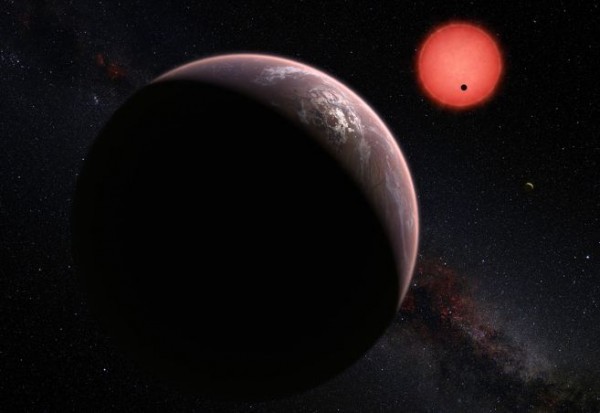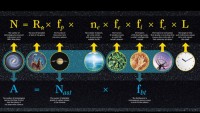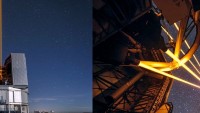Three Potentially Habitable Planets Found Only 40 Light Years Away
| Arthur Dominic Villasanta | | May 03, 2016 08:21 AM EDT |
(Photo : ESA) The dwarf sun TRAPPIST-1 and its three potentially habitable exoplanets.
Astronomers have discovered three Earth-like exoplanets orbiting an ultracool dwarf star just 40 light years away, making them best targets so far in the search for extraterrestrial life. One astronomer said they had hit the jackpot with this discovery.
A team of astronomers from MIT, the University of Liège in Belgium and other institutions discovered the planetary trio and said the sizes and temperatures of these exoplanets are comparable to those of Earth and Venus. They described these planets as the best targets yet discovered in the search for life outside the solar system.
Like Us on Facebook
The planets in the constellation Aquarius were discovered using TRAPPIST (TRAnsiting Planets and PlanetesImals Small Telescope), a 60 centimeter telescope in Chile operated by the University of Liège. Using infrared wavelengths, TRAPPIST is designed to focus on 60 nearby dwarf stars. It was built by Michael Gillon and Emmanuel Jehin as a proof-of-concept telescope focused on these 60 small stars.
The three planets orbit the ultracool dwarf star named 2MASS J23062928-0502285, which has since been renamed TRAPPIST-1. This dwarf star is the size of Jupiter and is one-eighth the size of our sun but significantly cooler.
The two innermost planets (TRAPPIST-1b and TRAPPIST 1c) orbit the star in 1.5 and 2.4 days while the third planet (TRAPPIST-1d) might orbit TRAPPIST-1 anywhere from four to 73 days. TRAPPIST-1d might have liquid water and simple life forms.
Considering their sizes and distances to TRAPPIST-1, all three planets may have regions with temperatures well below 400 kelvin, which is within a range suitable for sustaining liquid water and life.
Scientists will soon study the planets' atmospheric compositions since the planets are just 40 light years from Earth. They will also be able to assess the planets' habitability and whether life actually exists within this planetary system.
"These planets are so close, and their star so small, we can study their atmosphere and composition, and further down the road, which is within our generation, assess if they are actually inhabited," said Julien de Wit, a postdoc at the Department of Earth, Atmospheric, and Planetary Sciences. "All of these things are achievable, and within reach now. This is a jackpot for the field."
Astronomers have discovered all three exoplanets are likely tidally locked, meaning they have permanent day and night sides. The two planets closest to TRAPPIST-1, however, might have day sides that are too hot and night sides too cold to host any life forms. Astronomers are almost certain all three exoplanets are made of rock and ice.
There might, however, be a "sweet spot" on the western side of both planets. This is an area that still receives daylight but might be temperate enough to sustain conditions suitable for life. The third planet, the farthest from the star, might be entirely within the habitable zone.
De Wit says the next step facing the team is to discover if the planets are habitable.
"We will investigate what kind of atmosphere they have, and then will search for biomarkers and signs of life. We have facilities all over the globe and in space that are helping us, working from UV to radio, in all different wavelengths to tell us everything we want to know about this system. So many people will get to play with this (system)."
The study, whose lead authors are Gillon and Jehin, was published in the journal Nature.
TagsMIT, University of Liège, TRAPPIST, TRAnsiting Planets and PlanetesImals Small Telescope, TRAPPIST-1, 2MASS J23062928-0502285
©2015 Chinatopix All rights reserved. Do not reproduce without permission
EDITOR'S PICKS
-

Did the Trump administration just announce plans for a trade war with ‘hostile’ China and Russia?
-

US Senate passes Taiwan travel bill slammed by China
-

As Yan Sihong’s family grieves, here are other Chinese students who went missing abroad. Some have never been found
-

Beijing blasts Western critics who ‘smear China’ with the term sharp power
-

China Envoy Seeks to Defuse Tensions With U.S. as a Trade War Brews
-

Singapore's Deputy PM Provides Bitcoin Vote of Confidence Amid China's Blanket Bans
-

China warns investors over risks in overseas virtual currency trading
-

Chinese government most trustworthy: survey
-

Kashima Antlers On Course For Back-To-Back Titles
MOST POPULAR
LATEST NEWS
Zhou Yongkang: China's Former Security Chief Sentenced to Life in Prison

China's former Chief of the Ministry of Public Security, Zhou Yongkang, has been given a life sentence after he was found guilty of abusing his office, bribery and deliberately ... Full Article
TRENDING STORY

China Pork Prices Expected to Stabilize As The Supplies Recover

Elephone P9000 Smartphone is now on Sale on Amazon India

There's a Big Chance Cliffhangers Won't Still Be Resolved When Grey's Anatomy Season 13 Returns

Supreme Court Ruled on Samsung vs Apple Dispute for Patent Infringement

Microsoft Surface Pro 5 Rumors and Release Date: What is the Latest?














